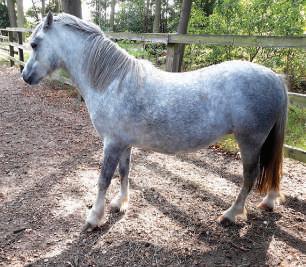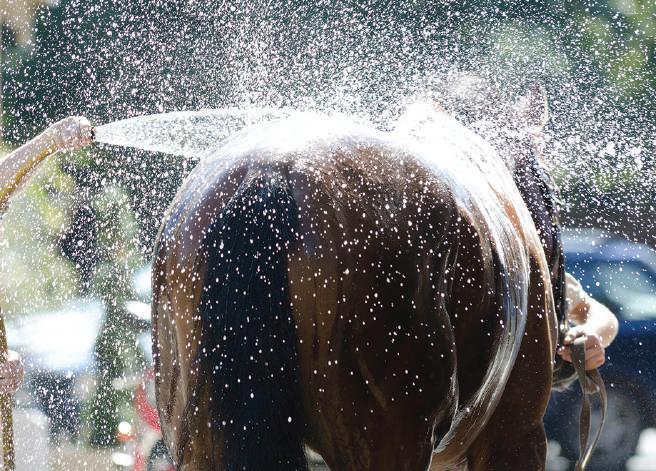
6 minute read
Health and Welfare
Vet Watch
Presented by
Advertisement
ROSSDALES VETERINARY SURGEONS
Beaufort Cottage Stables High Street, Newmarket CB8 8JS T: 01638 663150 E: practice@rossdales.com
www.rossdales.com

By Lorna Brokenshire-Dyke MRCVS
HEALTH ISSUES TO LOOK OUT FOR THIS SUMMER SEASONAL CONCERNS
While most of us enjoy the summer months, they can bring a number of health issues for horses and ponies. Some of the most common ones are highlighted here.
Excess weight and laminitis Many horses and ponies have increased turnout at this time of
Changes in weight should be monitored regularly with a weigh tape
year. Even if a paddock doesn’t appear to have much grass on it, this can be deceptive. Growing grass will be consumed as quickly as it grows, and stressed, closely grazed grass is especially rich in sugars. This contributes to the risk of laminitis. Ideally, your horse’s weight and condition should be monitored regularly, using a weigh tape and a body condition scoring system. Studies have shown that the risk of laminitis increases both in overweight horses and, particularly, in those gaining weight. Your vet or an equine nutritionist will be happy to offer weight management advice. It
A pony in a typical ‘laminitic stance’, shifting its weight
may be useful to discuss investigations of metabolic disorders such as Equine Cushings Disease (PPID) or Equine Metabolic Syndrome (insulin dysregulation), both of which significantly increase the risk of laminitis, but can be easily diagnosed with blood tests. Signs of acute laminitis range from subtle (warm feet and increased digital pulses) to more obvious (reluctance to move and
the typical ‘laminitic stance’). Chronic laminitis often results in visible changes to the foot, reflecting altered hoof growth and movement of the pedal bone. If you suspect laminitis, contact your vet immediately.
Skin conditions Summer skin conditions are frequently caused by biting insects, sunburn, heat, or bacterial infections in humid conditions. They are usually diagnosed using the animal’s history, season and clinical signs, but may require a hair sample, skin scrape or biopsy sample to be examined in a laboratory.
Sweet itch One of the most common allergic skin conditions in horses is ‘sweet itch’. In most cases, it is a reaction to midge (Culicoides) bites, but occasionally to horseflies, mosquitoes and other biting insects. Most horses do not show signs until they are 4-5 years old and the condition typically gets worse with age. Clinical signs include intense pruritis (itchiness) – rubbing the neck, mane, head, back and tailbase is typical – as well as tailswishing and fidgety behaviour. These signs may appear worse when midge activity peaks at dawn and dusk. Raised, crusty lumps may develop along the back and sometimes horses rub themselves so vigorously that the skin becomes hairless and, in the worst cases, broken and secondarily infected. With chronic sweet itch, the skin becomes thickened, with hair loss, especially on the neck, withers and tail-head. Avoiding exposure to midges and other biting insects is the best strategy, achieved through the use of insect repellants (such as permethrin), full cover fly rugs and face masks. Stabling at dawn and dusk, when midge activity is highest, can help. In the worst affected individuals, consideration should be given to moving horses away from habitats where midges thrive, including standing water. In some cases, anti-histamines or corticosteroids may be prescribed by your vet. Where skin becomes secondarily infected, antimicrobials may be prescribed.
Sunburn/photosensitisation Horses with any pink skin (usually around the muzzle, eyes and limbs) are at risk of sunburn and high factor sun cream should be applied to those areas to help prevent redness, peeling and blistering. Removing affected horses from the sun is important, as is addressing those areas that have been burnt. If the sunburn is mild, discomfort can be soothed by moisturising the dry skin and using products such as aloe vera gel. Occasionally, the sunburnt area may become secondary infected and Horses with pink skin are at your vet may prescribe a risk of sunburn topical antimicrobial cream to help limit infection and soothe the skin. To prevent further sunburn, consider turning your horse out at night, or in a field with plenty of shade to stand under. Full face masks are useful for covering sensitive areas prone to burning. Sunburn can also be a result of photosensitisation. This is an abnormal reaction to sunlight when a 'photodynamic agent' such as a plant, chemical, fungi or bacteria in the skin is present in the horse's circulation due to ingestion or absorption through the skin. Primary photosensitisation is caused by ingestion of chemicals from certain plants, such as St John’s Wort. These chemicals settle in the skin where they react to UV light, making the horse’s skin susceptible to burning. Sunburn can also occur as a result of liver disease in horses (secondary photosensitisation,) where toxins normally processed by the liver sensitise the skin to UV light, often resulting in severe and widespread sunburn. The difference between these different types of sunburn will require veterinary diagnosis.
VET PROFILE
LORNA BROKENSHIREDYKE
BA, MA, VETMB, MRCVS Lorna is a member of Rossdales Veterinary Surgeons’ sport and leisure horse ambulatory team in Newmarket. She qualified as a veterinary surgeon in 2009 from the University of Cambridge and subsequently joined Rossdales, completing two internships at the Hospital and Diagnostic Centre. In 2012, she helped establish the Rossdales Hertfordshire branch, working as an ambulatory vet. After leaving the practice in 2015 to focus on her young family, she then spent five years as a senior equine vet in a mixed practice in Suffolk. She rejoined Rossdales in 2021 and is currently studying to turn a Postgraduate Diploma into a Master of Science in Veterinary Physiotherapy.
Heat stress and dehydration Horses’ water intake increases considerably during hot weather and exercise. Several sources of water are important for groups of horses so that dominant horses can’t prevent more timid ones from drinking. Some horses prefer water from home whilst travelling or competing. Most horses struggle to acclimatise to sudden increases in temperature. Exercise should be planned for the coolest part of the day and extra care should be taken whilst travelling, with more frequent checks, and consideration given to reduced warm up times during competition. Heat stress can occur when horses work in excessively hot or humid conditions and is a condition that must be treated immediately. Body temperature can rise dangerously due to massive heat production from the muscles, insufficient heat loss, excessive loss of fluids and electrolytes and oxygen being consumed faster than it is being delivered. The consequences can be serious and occasionally fatal. If your horse displays any of these signs (right), aggressive cooling methods are required to reduce the horse’s temperature as quickly as possible. The most effective cooling has been shown to be repeated applications of copious cold water, WITHOUT scraping between applications. The horse should be walked slowly in the shade between applications and monitored regularly including taking repeat rectal temperature. Always seek veterinary help if you suspect a case of heat stress. More intensive treatment with intravenous fluids and medical management may be required.
www.rossdales.com

Use plenty of cold water to cool your horse following exercise in hot weather
LOOK OUT FOR THESE
Signs of possible heat stress
• Rectal temperature
above 39.0°C
• Heavy and/or rapid breathing • Rapid heart rate
(sometimes an irregular rhythm)
• Excessive sweating • Lethargy or restlessness • Stumbling or going down • Muscle spasms • Kicking out with the back legs • Slow recovery after
exercise
• Dark urine/reduced urination • Collapse and, in serious
cases, convulsions
PRODUCT NEWS...
Kentucky Liquid Joint Supplement provides key nutrients, including Glucosamine Hydrochloride, MSM and Boswellia, to provide nutritional support for both cartilage repair, and to help maintain healthy joint fluid to lubricate and nourish the joint, supporting joint health and comfort, and reducing stiffness. RRP: £29.50/1ltr. www.equine-america.co.uk
Citro Shield Gel from Veredus is a fly repellent gel, non-toxic and hypoallergenic, made of citronella, geranium and cinnamon. Specially formulated for use on delicate and sensitive areas such as eyes and muzzle. The gel is safe for use on skin abrasions. RRP: £26/500ml. www.zebra products.co.uk





